Are you ready to learn about permaculture? But perhaps you have a full-time job or children at home that prevent you from attending an in-person permaculture design course. Thankfully, there are now online permaculture design courses that allow you to learn the information you need to know via the Internet, on your own terms.
What is an online permaculture design course? An online permaculture design course (PDC) is a course that teaches the complete principles and foundations of permaculture design over the internet. It allows a more flexible and personalized approach to learning about permaculture without needing to attend in-person classes or seminars.
In this article, you’ll learn what an online PDC is, what it involves, the benefits of enrolling in one, and more.
What Is A Permaculture Design Course (PDC)?
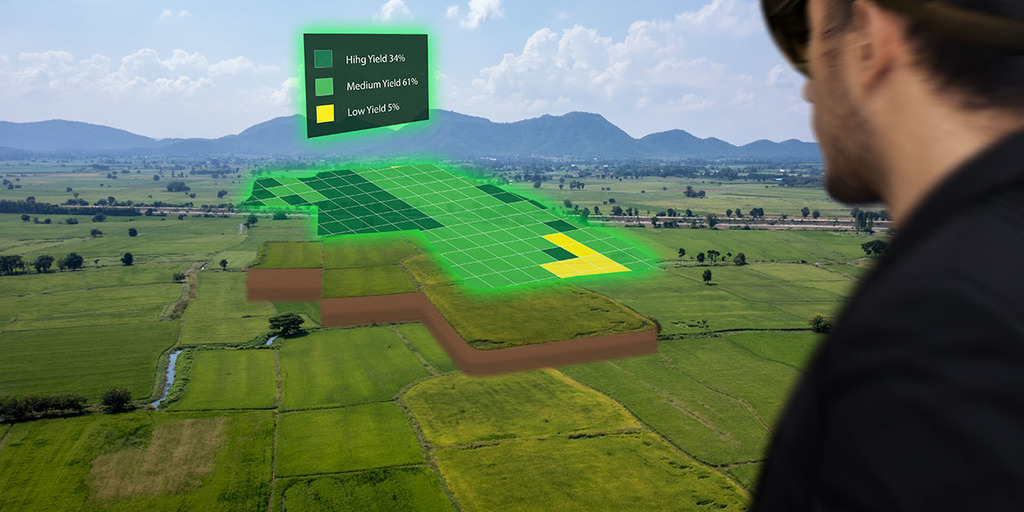
Permaculture design courses are used to teach the foundations and principles of permaculture to hundreds or thousands of people at a time.
It’s a great way for teachers to offer a university-like course, rather than having to instruct people in a one-on-one setting.
Permaculture design courses can range in price from being free, up to a thousand dollars or more.
At the end of successfully completing a permaculture design course, you may receive certification from your instructors in the form of a diploma.
This confirms that you’ve gained the knowledge of permaculture necessary to put the principles into practice.
PDCs are often taught in-person. But now there are several online permaculture design courses that make it much more convenient to learn about permaculture.
They enable you to learn from home at your own pace, without needing to take time off or travel across the country to attend an in-person course.
What Does An Online PDC Involve?

An online permaculture design course can vary quite a bit from one instructor to another. But if it’s truly a high quality course, there are some basic things that it should include.
First of all, you should have an instructor with the experience or credentials needed to teach.
Just about anyone can make an online course nowadays, so make sure before you sign up that you’re learning from someone respected and knowledgable about their field.
I recommend looking for an online permaculture design course that includes at least 72 hours of content and curriculum.
Less than this amount, and you probably aren’t receiving the full knowledge of permaculture that you need.
A good course won’t simply be comprised of video lessons, but will also contain keynotes and commentary, personal online support and a way to connect with your classmates, quizzes, final hands-on projects, self-study time, and more.
Typically the final assignment will be to plan and draw a fully sustainable design for a given property, which provides you with an opportunity to put all of your permaculture design principles to the test.
You can also learn my guides about permaculture farming techniques, the steps in designing and creating your own farm here:
- Read my guide on How To Start A Permaculture Garden here.
- Learn my guide on How To Create A Permaculture Orchard.
Examples of Online Permaculture Design Courses
Here are some examples of high-quality online permaculture design courses that I’d recommend to get you started in your search.
1. High Sierra Permaculture’s Holistic Homestead Academy
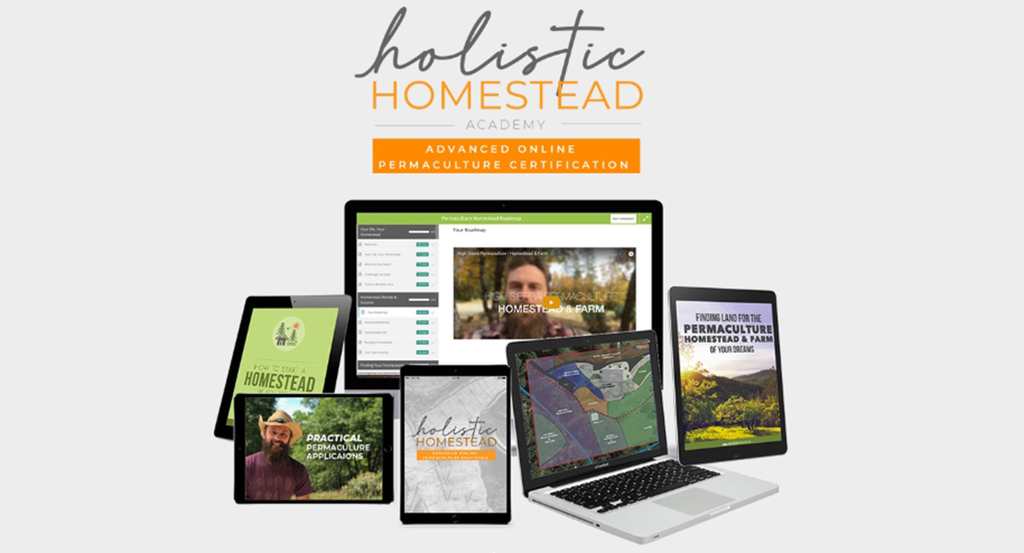
Link: https://highsierrapermaculture.com/online-courses/holistic-homestead-academy-wait/
This PDC is taught by Bret from Holistic Homestead. Course content is released on a set schedule.
The next program begins on February 25th, 2019 and a new module is released every month for 12 months. At the end, you’ll receive a permaculture design certification upon successful completion.
This course was designed with busy people in mind. You’ll need to invest at least 2 or 3 hours per month to take in the material, do the coursework, and apply the practical principles that you learn.
But the more time that you invest, the more you’ll get out of the course.
If you get stuck, there is a Facebook group that accompanies the course to help you along the way. You can also contact Bret for support if you can’t get the answers you need from the community.
The Holistic Homestead Academy package costs $1,397 and includes 3 courses with 12 modules each, monthly support emails and Q&A sessions, module worksheets, a private Facebook group, and plenty of additional bonuses.
2. Geoff Lawton’s Online PDC 2.0
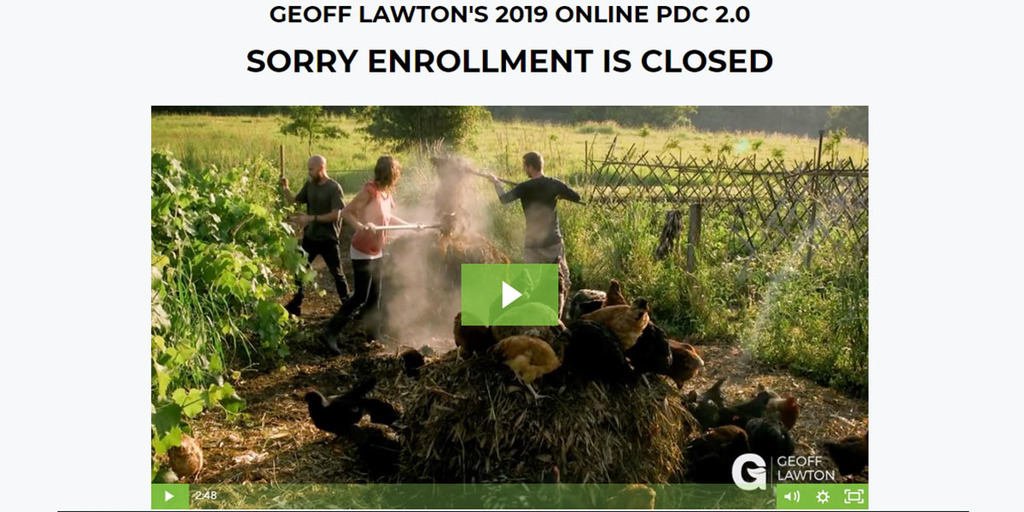
Link: https://www.discoverpermaculture.com/pdc-2019
Geoff Lawton’s online PDC for 2020 is not currently open for enrollment, but you can sign up to be added to the waiting list and get notified when it’s available again.
The course includes a generous 28-week pace. Previously the course was taught in only 10 weeks, but it has been extended to nearly triple the time to allow for a more stress-free learning experience.
In addition to 750+ instructional lessons, the material includes video Q&A, community discussion, and per-module projects. You should expect to invest anywhere from 2.5 to 6 hours per week into the course.
If you want to get to know a bit more about Geoff and his approaches while waiting for enrollment for the 2020 course to open, you can view his Permaculture Masterclass four-part series here for free.
3. Ridgedale Permaculture’s Online PDC
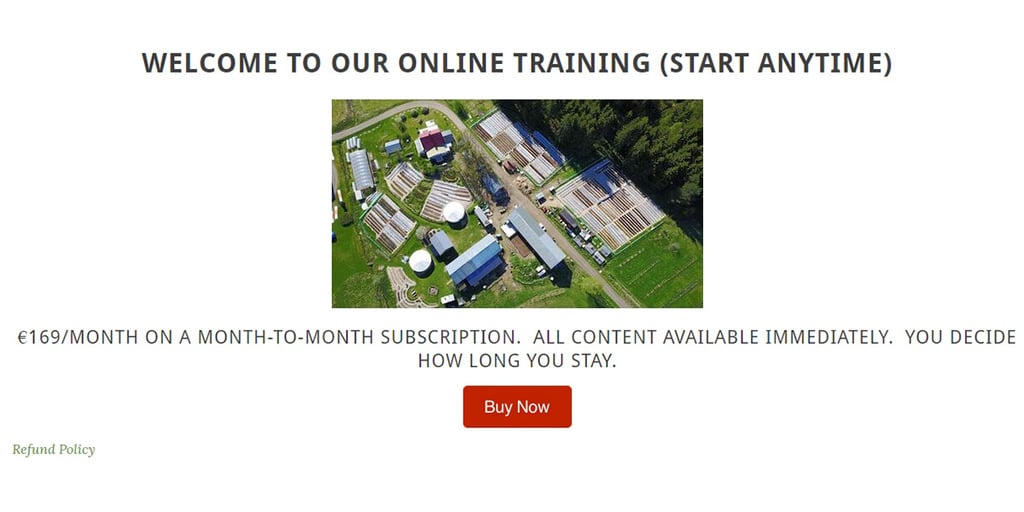
Link: http://www.ridgedalepermaculture.com/online-training.html
This online PDC is taught by Richard Perkins. Its focus is on farm scale permaculture design and regenerative agriculture.
The pricing for the course is a €149 month-to-month subscription. You get access to all of the content right away, and you decide how long you want to stay enrolled.
The course covers everything you need to know to start a permaculture farm.
Including maps and landform, keyline design, water systems, trees and woody crops, building up fencing and infrastructure, pastured broilers, pastured hens and egg-mobiles, grass and grazing, biointensive no-dig market gardening, how to nurture the soil food web, and all about the farm economy, marketing, and phase planning.
This course is a great choice if you want to learn how to make a living for yourself with permaculture, even if you’re starting on rented land.
4. Patrick Whitefield Associates – The Land Course Online

Link: http://patrickwhitefield.co.uk/online/
Patrick Whitefield Associates offers give modules to choose from, including a fully certified permaculture design course.
Other courses each focus on the topics of ecology, organic growing, sustainable forestry, and the soil. Each module is really a full course unto itself.
This course is a good choice if you want to learn how to work the land in a sustainable way, or even if you’re already working the land and are just looking to increase your skills.
It includes recorded webinars and quarterly web sessions, and a wealth of text, images, films, and presentations.
Any one of the first four modules are £100 each and the permaculture module is £300 if all bought individually. Or you can get the whole package for £550 and save yourself £150.
5. Oregon State University’s Intro to Permaculture
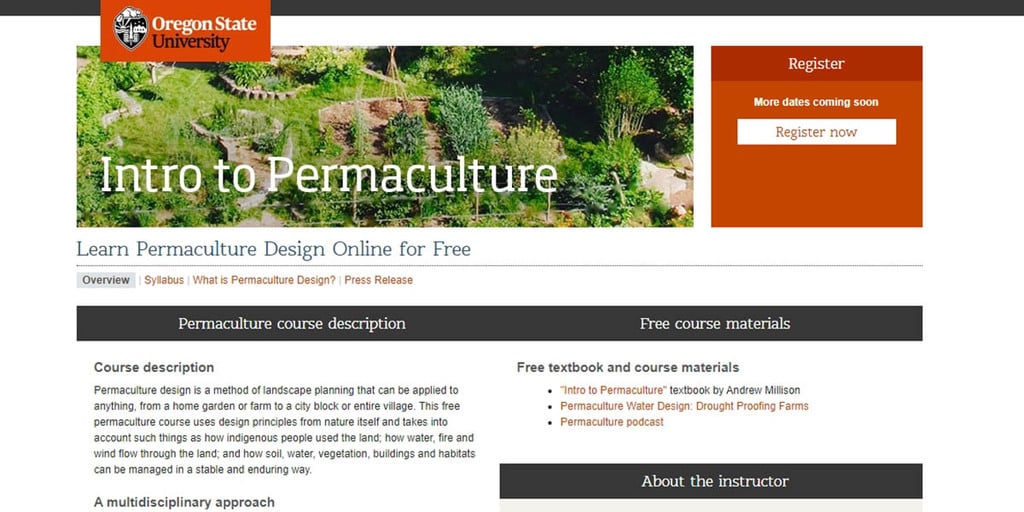
Link: https://open.oregonstate.edu/courses/permaculture/
If you’re looking for a more an online PDC that takes a more academic approach, this course might be what you’re looking for. Best of all, the course materials and textbook are completely free.
The course instructor is Andrew Millison, who has nearly 20 years of experience in designing and building permaculture projects.
The course covers a wide variety of permaculture design principles and methods. It’s a great choice for the novice and professional alike, and no previous experience is required.
The Benefits of Completing An Online Permaculture Design Course

1) Flexibility
Some online permaculture design courses will have a more rigid schedule. But most allow you to work through the course material and assignments at your own pace.
You can work on the course material for just an hour or two in the evenings or weekends.
So it’s a great way to learn about permaculture even if you’ve got a full-time job, kids to take care of, or other obligations that make in-person classes or more formal education impossible.
The one caveat that I would give is to examine course pricing carefully if you’re looking for a more flexible option.
Many online PDC courses will offer a weekly or monthly ongoing fee, or alternatively you can pay a one-time fee to get access to the course material forever.
A course may cost $50 per week if you’re paying on a weekly schedule, or $1,000 to buy it outright.
When you’re deciding which pricing option to select, be reasonable with how long you expect it to take for you to finish the course.
Paying $50 per week can be a great bargain if you plan to learn all the course material in a month.
But if you think it will take you 5 months or more to work through the course, it can actually be the better option to pay the one-time fee upfront.
2) Community
Just because you’re learning about permaculture design over the internet, that doesn’t mean it needs to be a completely isolating experience.
Look for courses that include one-on-one assistance from your instructor if you get stuck. As well as a discussion board or some other way for you to keep in contact with other people who are working through your course.
You can bounce ideas off other members who may have more knowledge and experience than you, and it also helps to build a sense of camaraderie and give you the motivation to keep going, when you’re constantly hearing the success stories of other students.
An online PDC course brings together a lot of like-minded people, and gives a great chance to make friends and share your interests, where people in your everyday life may not have the same passion about permaculture that you have.
3) Motivation and Commitment
If you’re trying to just independently learn permaculture on your own by reading books and watching free videos, there are lots of distractions that can come up.
There are a million excuses that you can come up with for doing other things instead of learning about permaculture.
But if permaculture design is really something you’re passionate about and want to learn, then paying for an online PDC is a way to commit and give yourself permission to engross yourself in your area of interest.
Having a structured course enables you to carve out the time you need to really devote to learning about permaculture.
It gives you an avenue to focus on principles, ideas, and strategies of permaculture that are important to you, and it helps to remove excuses and distractions.
4) Convenience and Completeness
Pretty much anything you want to learn nowadays is online for free. So if you really wanted to, you could search around various parts of the internet and digest as much information about permaculture as you can.
But for most people, this isn’t a very practical approach. You’ll devote a lot more time and energy than needed, and pick up outdated or irrelevant information along the way.
Having a set online permaculture design course helps streamline the process. It will give you only the crucial information that you need to know, all in one place.
Paying a small fee helps save you hundreds of hours trying to collect and take in information from dozens of different sources.
Questions To Ask Yourself Before Picking An Online Permaculture Design Course

When choosing which online permaculture design course will be right for you, here are some questions that I think are important to ask yourself.
They’ll help you to find the course that makes the most sense for your personal situation.
1. Does The Instructor Seem Right For You?
Different personalities and communication styles are better suited for some people than others. Some people may love the approach of one teacher, while another person may absolutely hate it.
Looking at the sales page and doing a little bit of background research on the person teaching your course is worth your time. Especially if you’re going to be paying for a course that costs hundreds of dollars.
Go with your gut instinct when you first hear and see a video with your instructor. Pick someone who resonates with you.
If there’s something about the way they speak or their mannerisms that you’re not a fan of after just a couple of minutes, you aren’t going to want to watch hours upon hours of content delivered by them.
Some people want a no-nonsense teacher who gets right to the point and is very factual.
Others might want a more personable and dynamic instructor, where even if they go a bit off-tangent, they keep you engaged with the course material.
2. Why Are You Learning Permaculture?
Online permaculture design courses aren’t just a one-size-fits-all approach. You should pick a course that suits your goals.
Some courses may be more intensive and focused on someone who is looking to become a permaculture farmer and make a full-time income from the skills they learn.
Other courses may be more aimed at a hobbyist who just wants to apply permaculture design practices in their garden.
It’s best to pick a course that meets your needs and is the most relevant, even if it’s not the most flashy on the surface.
Take some time before choosing a course to really consider what your goals are and what you’re looking to take away from an online course.
- If you want to become a homesteader you can also read my How To Start a Homestead Beginners Guide.
3. What Are Your Specific Needs?
It’s best to pick a course and instructor that best suits what your needs are. The best online permaculture design course might be taught someone who lives in the Southern US or somewhere tropical.
But that won’t be very relevant to how you’ll want to grow and what plants you’ll need to use if you live in a colder climate where temperatures drop below 0 Celcius in the winter.
Some courses are designed more for large rural properties, while others are more suited for suburban or urban land use. Pick a course that focuses on the way you’ll be growing.
If you’re planning to use your permaculture knowledge for volunteer work, it might be worth looking for a course with a more broad outlook that covers a wide variety of climates.
- Read these 21 Of The Best Small Scale Farming Ideas you can do on your small-scale farm.
4. Are You Interested In The “Why”, or Do You Just Want To Grow?
Some courses go into more depth when it comes to social or political commentary.
Some online permaculture design course instructors may be coming at the course from a very specific lifestyle or belief system that might not jive well with what you need.
If raising livestock sustainably is something that’s important to you, then you might not want to sign up for a permaculture course that’s taught by a vocally vegan instructor.
Likewise if you’re staunchly irreligious, you may not want to learn from an instructor with very spiritual views on nature and permaculture.
On the other hand, if you’re interested in learning more than just the technical details of permaculture, these different perspectives and extra details might be what you’re looking for.
Be sure to read through the course description to ensure the content is what you’re looking for and what you agree with.
5. Are You Looking To Learn About Permaculture Design As A Whole, or Just A Specific Skill?
While I think permaculture design is a valuable skill that anyone interested in growing food should learn, the truth is that a full online PDC isn’t necessary for everyone.
If you’re a beginner gardener just starting your journey into the world of permaculture, a full 50+ hour course might be too overwhelming and difficult to actually implement.
If you’re just looking to learn a specific skill like no-till farming, you may be better off finding a more specific online course that focuses only on that topic.
Instead of taking on all types of information that might not be relevant or useful for you at this stage in your process.
- Whether you want to become a full-time farmer or just earn a little money on the side read my guide of how to start a market garden.
Conclusion
An online PDC can be a great way to get an education about permaculture design.
Especially for those with busy schedules or limited budgets, who aren’t able to travel or make the time for in-person permaculture classes.
When you’re choosing an online PDC, first decide what your goals are and the outcomes that you’re looking for.
Then examine the course materials and instructors for each option to see which will best suit your needs.
Ready to get started? Try implementing permaculture elements in your backyard.
